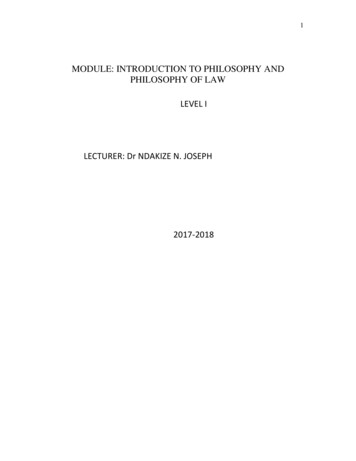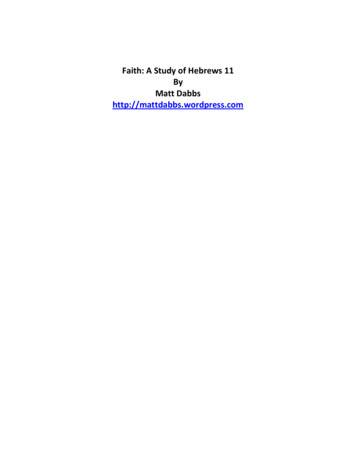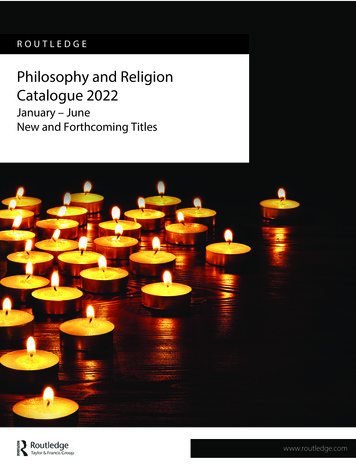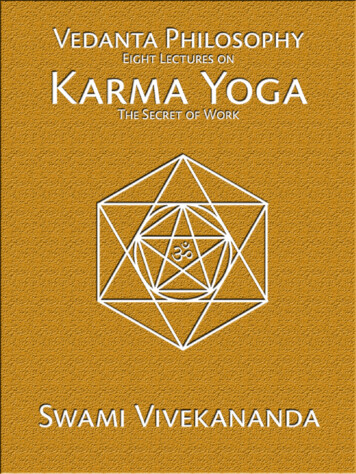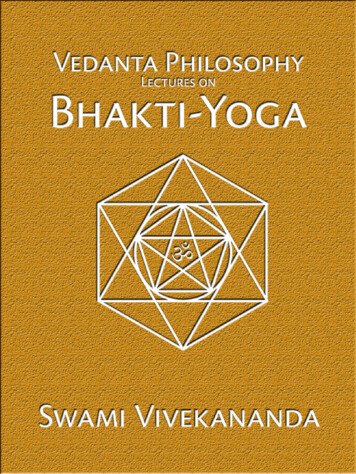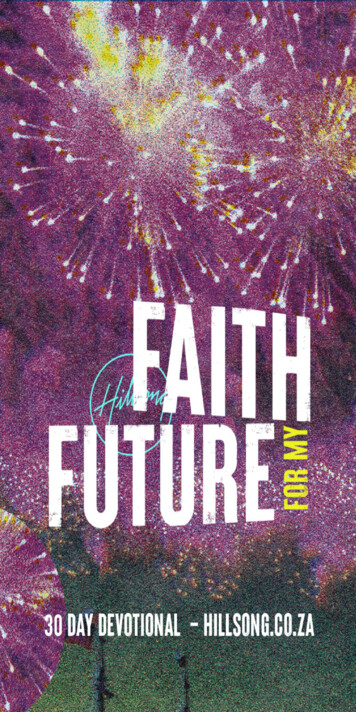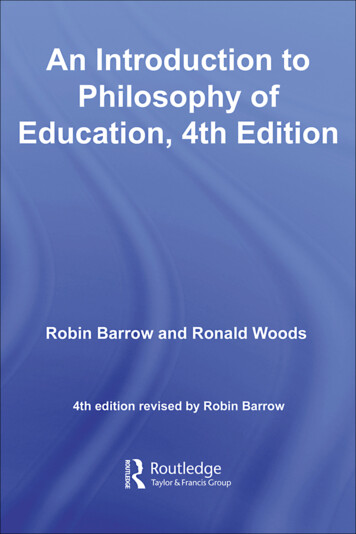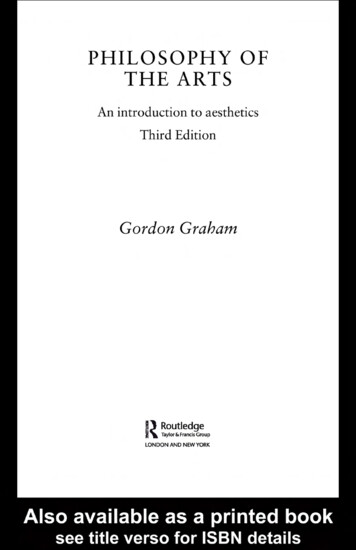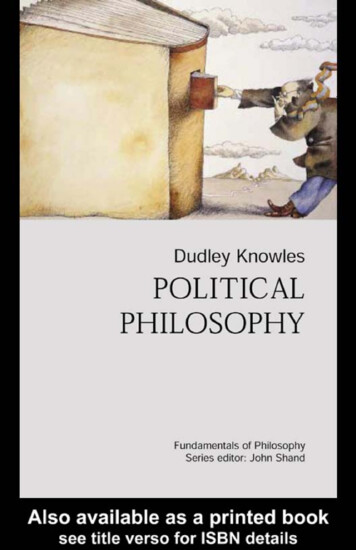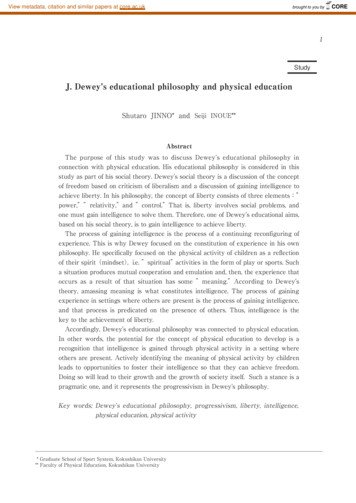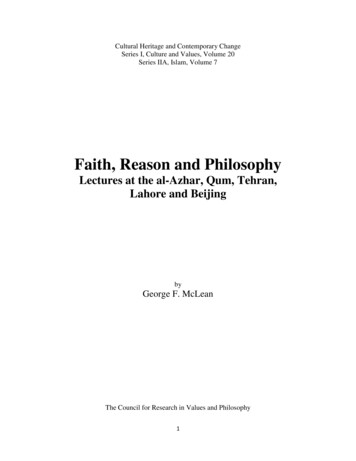
Transcription
Cultural Heritage and Contemporary ChangeSeries I, Culture and Values, Volume 20Series IIA, Islam, Volume 7Faith, Reason and PhilosophyLectures at the al-Azhar, Qum, Tehran,Lahore and BeijingbyGeorge F. McLeanThe Council for Research in Values and Philosophy1
Copyright 2000 byThe Council for Research in Values and PhilosophyGibbons Hall B-20620 Michigan Avenue, NEWashington, D.C. 20064All rights reservedPrinted in the United States of AmericaLibrary of Congress Cataloging-in-PublicationMcLean, George F.Faith, reason and philosophy : a series of lectures at Cairo, Tehran, Qom, Lahore, andBeijing / George F. McLean.p.cm. — (Cultural heritage and contemporary change. Series I. Culture and values ; vol.20 ; Series IIA, Islam ; vol. 7)Includes bibliographical references and index.1. Faith and reason-Christianity. 2. Faith and reason--Islam. I. Catholic Church. Pope(1978- : John Paul II). Fides et ratio. English. II. Title. III. Series. IV. Series cultural heritage andcontemporary change. Series I, Culture and values ; vol. 20. Series IIA, Islam ; vol. 7.BT50.M345 200000-031602210—dc21CIPISBN 1-56518-130-1 (pbk.)2
Table of ContentsIntroduction1Part I. Context: The Evolution of Reason as Awareness of GodChapter I. An Archeology of Reason as Inherently Religious7Chapter II. Systematic Graeco-Christian Philosophy23Part II. Medieval Islamic and Christian Philosophies on Faith and Reason: Crisis andResponseChapter III. Al-Ghazali: a Medieval Crisis of Faith and Reason39Chapter IV. The Role of Reason in Belief: A Christian Response51Chapter V. Mulla Sadra’s Philosophy of Existence: Islamic and Christian Contributions 65Part III. The Modern Crisis of Reason and the Response in FaithChapter VI. The Crisis of Reason Today and the Response in Faith85Chapter VII. Philosophy in the Context of Faith95Chapter VIII. The Meaning of Faith for Philosophy105Part IV. New Collaboration of Faith and Reason: Future Directions for IslamicChristian Cooperation and for Religion in Chinese ThoughtLecture I: Reasoning in Faith: An Address at Mofid University, Qom, 1999121Lecture II: Faith and Reason: An Address at the Al-Azhar University, Cairo 1999135Lecture III: Philosophy and Religion: An Address at People’s University of China,Beijing, 2000145Appendix. Fides et Ratio: Encyclical Letter of Pope John Paul II1553
IntroductionIn considering the relation of faith and reason it is important to appreciate that the issuegenerally is viewed from the perspective of the secular rationalism which has characterized muchof the modern age. This is the cultural context within which we are born; it constitutes the glassesthrough which our world is interpreted.There are various and complex reasons for this. One, as with John Locke, is the desire to makeeverything patent to everyone in order to facilitate the transfer of the exercise of power to popularlyelected authorities. For this everyone needed equal access to all that entered into the debate. Lockerecast the understanding of human knowledge on the basis of a story — which Wittgenstein foundincorrect — of its origin whereby all was sense observation or what could be done with the ideasit produced. Religious ideas were not unwelcome to Locke — he wrote extensive Biblicalcommentaries — but they came from without and were added over and above reason in accordwith the new reformation theology.In the liberal mode, some would see the modern person as freed from all hierarchy, whetherstate or ecclesiastical, and competing equally in function of the new capitalist ideology. Others,such as Rousseau would return all to a fictitious state of nature prior to the development of anysuperstructure.All would converge in the supposition that the basic human character was a-religious, definedby contrast to faith and hence secular in the sense of being concerned with life only in this universeof limited and temporal beings, in terms of which all would be judged. Religion then, if it were tobe justified at all, would need to be seen not as gratitude and honor to God, but as service tohumanity understood then reductively in terms only of its life in this changing universe.It is precisely this assumption that has proven inadequate, indeed thoroughly destructive. Thehope of founding thereby a worldly utopia during the 20th century has been drowned by wars hotand cold. It now sinks under waves of mutual hatred, descending even into genocide on a numberof continents.As a result "humanist" assumptions of the Enlightenment now come to appear ever moreinhumane and it is important to review their basic assumptions. Prime among these is the issue ofthe context within which humanity is to be understood. Is it the self-enclosed and self-sufficientindividual seen as creator of all else, or is it the relation between nature and God in a pattern ofinterchange that is open and fruitful. If so then faith is not a superstructure which can be dispensedwith, but is foundational and indispensable; nor is it a constraint upon reason, but its naturalcontext, inspiration and support.The chapters of this book largely are lectures delivered at the University of the Punjab inLahore.Part I of this work surveys human development and examines how reason first emerged andthen developed for literally thousands if not millions of years — almost its entire lifespan — withina religious context.This follows Heidegger’s suggestion that human reason chooses among different paths atcritical junctures, thereby developing some capabilities while leaving others undeveloped. Hencethe real way forward, he suggests, is not incremental steps along the pathways already developed,but a step back to take up different possibilities not yet explored.5
In this light we begin by returning to the initial totemic and then mythic stages of humanawareness to see if and in what way these were religious in content, method and character. Thiswill constitute an archeology of human consciousness, after which we shall proceed to investigatethe religious structure of participation in the philosophy of Graeco-Christian and Islamic thought.For more extensive studies of these issues the reader is referred to my Ways to God: The IqbalLecture(Washington: The Council for Research in Values and Philosophy, 1999), where separatechapters are devoted to these themes which here are sketched more schematically.This provides the context for the main burden of this work which concerns directly the issueof faith and reason and is axised on two crises.Part II departs from the medieval crisis of al-Ghazali as described in his Munqid and followswith the interchange of related work in the Christian and Islamic thought, especially that of ThomasAquinas and Mulla Sadra.Part III concerns the present crisis of faith and reason generated by disillusionment withEnlightenment rationalism at the end of the 20th century. Reversing both the modern rejection ofreligion by reason and the recent "post-modern" drive to dismiss reason, the Encyclical Fides etRatio calls instead for a renewal of reason on a more integral bases. Long dismissed by reason asinadequately enlightened, it is religion which now affirms the dignity of humankind and the highmission of reason in time.Part IV looks for the meaning both of philosophy for faith and of faith for philosophy.Parts I-III are the series of lectures delivered at the University of the Punjab beginning withthe Iqbal lecture, to which is adjoined lecture on Mulla Sadra prepared for the conference on histhought in Tehran.Part IV consists of three related lectures on faith and reason delivered at the al-AzharUniversity in Cairo, Egypt, at Mofid University in Qum, Iran, and at People’s University of China,Beijing on the occasion of the renaming of its Department of Philosophy as "The Department ofPhilosophy and Religion".To these are appended the encyclical letter Fides et Ratio (Faith and Reason) of Sept 14, 1998,by Pope John Paul II. In it he studies the present juncture and rethinks in positive terms the relationof faith and reason and their mutual complementarity and contributions.6
Chapter IAn Archeology of Reason as Inherently ReligiousIn the modern secular context the foundational religious meaning of life has been extensivelyforgotten. Instead, the rare and quite recent phenomenon of a world view precinding from, orneutral to, the divine has come to be taken as the honest baseline from which the religious issueshould be considered. For Mohammed Iqbal this is quite out of the question, analogous to definingthe mind on the basis of but one (the analytic) of its limited processes. Hence, he does not go farin the first chapter of his Reconstruction of Religious Thought in Islam before stating as itsprinciple what the Vedanta Sutrasexemplified both in its text and in its structure, namely, that: "Itis in fact the presence of the total infinite in the movement of knowledge that makes finite thinkingpossible."1 The genius of his work is its powerful and intricate elaboration of this theme.To begin, in a typically brief but pregnant aside Iqbal notes that "to the primitive man allexperience was supernatural."2Rather than being simply a referece to dead facts from the past, thispoints to the total cumulative human experience regarding the essential importance of religion asmanifested by human life. It suggests, moreover, the common ground needed by the many culturesas they begin to interact more intensively. It is then the place to begin.From earliest times human thought has always and everywhere had a sacred center. It ispossible to track the evolution of this constant awareness by relating it to the three dimensions ofthe human mind. The first is the external senses of sight, touch and the like by which one receivesinformation from the external world. The second is the internal sense of imagination and memoryby which one assembles the received data. This is done in a manner which enables it to representthe original whole from which the various senses draw their specific data, to represent these andother data in various combinations, and/or to recall this at a later time. Finally, beyond the externaland internal senses is the intellect by which one knows the nature of things and judges regardingtheir existence.3Not surprisingly, upon examination it appears that the actual evolution of human awarenessof the sacred follows this sequence of one’s natural capacities for knowledge. In all cases it isintellectual knowledge that is in play, for religious awareness concerns not the characteristics orshapes of sensible objects, but existence and indeed the one who gave his name as "I am WhoAm". This was articulated successively, first in terms of the external senses in the totemic stage ofthought, then in terms of the internal sense in the mythic period, and finally in properly intellectualterms as the origin of philosophy or science.4To follow this evolution it should be noted that for life in any human society as a grouping ofpersons there is a basic need to understand oneself and one’s relation to others. It should not bethought that these are necessarily two questions, rather than one. They will be diversely formalizedin the history of philosophy, but prior to any such formalization, indeed prior even to the capacityto formalize this as a speculative problem, some mode of lived empathy rather than antipathy mustbe possible. Plato later worked out formally and in detail that the unity of the multiple is possibleonly on the basis of something that is one, but the history of human life manifests that present inthe awareness of the early peoples and according to their mode of awareness there always has beensome one reality in terms of which they understood all to be related.7
Totemic Thought (see Chapter II of Ways to God)The primitive or foundational mode of self-understanding was totemic. The earliestunderstanding by peoples of themselves and their unity with others and with nature was expressedin terms of some objects of the external senses, such as an animal or bird. Peoples spoke ofthemselves by simple identity with the animal or bird which was the totem of their clan. LevyBruhl expressed this in a law of participation: persons were in some way both themselves and theirtotem. They saw themselves not merely as in some manner like, or descendent from, their totem,but instead asserted directly, e.g., "I am lion." In these terms they founded their identity anddignity, considered themselves bound to all others who had the same totem, and understood byanalogy of their totem with that of other tribes the relations between their two peoples for marriageand the like.5Moreover, the totem, in turn, was not simply one animal among others, but was in a senselimitless: no matter how many persons were born to the tribe the potentiality or resources of thetotem was never exhausted — without limit there was always room for one more. Further, thetotem was shown special respect, such as not being sold, used for food or other utilitarian purposeswhich would make it subservient to the individual members of the tribe or clan. Whereas otherthings might be said to be possessed and used, the totem was the subject of direct predication: onemight say that he had a horse or other animal, but only of the totem would one say that he is, e.g.,lion.This concept brings important insight to the question of unity and distinctiveness which hasso divided the modern mind as characterized by a rationalist and analytic mode of thinking. Thetotem is not one in a series, but the unique reality in which each and all have their being — and,by the same token, their unity with all else.This is the key to social unity. Each is not indifferent to all else or related only externally oraccidentally to others in terms of temporal or spatial coincidence or functional service. Rather allare in principle and by their very being united to all, to whom they are naturally and mutuallymeaningful. Hence, one cannot totally subject anybody or indeed any thing to one’s own purpose;one cannot take things merely as means in a purely functional or utilitarian manner. Instead, allpersons are brothers or sisters and hence essentially social. This extends as well to nature in anecological sensitivity which only now is being recuperated.What is impressive in this is that all are united but without the loss of individuality that hasbeen the case in modern collectivisms. Instead, each individual, rather than being suppressed, hasmeaning in the unity of the totem. Hence, nothing one does is trivial, for every act is related to thewhole. No one is subservient as a tool or instrument; all are members of the whole. As each actstands in relation to the whole whose meaning it reflects, everything is of great moment. There isjustice and there are taboos, for there are standards which are not to be compromised.What then should be said of the totem as the key to a meaning in which all participate: is itreligious, is it divine? Some would answer in the affirmative and for a number of reasons:- it is the key to the unity of persons, recalling the religious statement of the brotherhood ofman in the fatherhood of God;- it has the absolute meaning of the religious center: the one God of Judaism, Christianity,Islam and Hinduism;- it is the key to the sacred meaning and dignity of all.8
In all these ways the totem is the religious center.Perhaps, however, it might be called proto-religious, in that while this principle of unity,though privileged and not reducible to humans, is not explicitly appreciated as being distinct from,and transcending the contents of this world.On the other hand, the effort of the mystic at the high end of the religious spectrum is preciselyto overcome the separation of human from God. The direction is immanent, namely, to unite one’slife with the divine, and to do so perhaps less by achieving transcendence than by entering moredeeply into the center of one’s own interiority. In this light totemic thought emerges in its trueimportance as something not to be escaped from, but to be recaptured and lived in new ways inthe midst of our much more complex society and more technically organized world.This has many of the characteristics of the classical a posteriori ways to the existence of God.(a) It began from a reality that did actually exist, namely, the successful and progressive life ofpeoples through the thousands of centuries which constitute almost the entirety of humanexperience. (b) It sought the principles of this existence, namely, the content of the understandingwhich made possible their successful human life. (c) It concluded in that totemic unity and fullnessin which people had both their being and their unity. Thus, it established the plenitude of, andparticipation in, the foundational totem as principle both of the human mind and of social life.This road differs, however, from the classical five ways of Thomas Aquinas. (a) Beingessentially anthropological in character, totemic thought began with people in the primitive stageof their development. (b) Being essentially hermeneutic in method, it attended to the conditions ofpossibility for the understanding manifested in their life. (c) This combination of anthropologicaland hermeneutic factors concluded to the plenitude, not as it is in itself, as a cause distinct from itseffect — the much later science of metaphysics will be required for that — but only as appreciatedby the primitive mind in its totemic mode.This difference should not be considered to be merely negative. The thought of the primitiveis not merely a poorer form of what people in subsequent ages would do better with improvedtools. Heidegger indicates the important sense in which especially by returning to the originsimportant progress can be made.The totem then was the unique limitless reality in terms of which all particular people andthings had their identity and interrelation. It was the sacred center of individual and communitylife in terms of which all had meaning and cohesion. It made possible the sense of both personaldignity and interpersonal relations, which were the most important aspects of human life. This itdid with a sense of direct immediacy that would be echoed, but never surpassed, in subsequentstages of more formally religious thought.Whether this be seen as religious or proto-religious, what it shows is that religion is notsomething added to a secular universe, but the basic and essential insight of even the simplestforms of human community. The issue then is not whether there be room for religion alongsidepublic life or how to protect one from the other, but how religion functions as the root of humanmeaning and community.Mythic Thought (see Chapter III of Ways to God)It is in the mythic stage of thinking that the explicitly religious element of the gods appears.Here it is important to see whether this is an external addition to, or imposition upon, prior thinkingor whether it is the unfolding or flowering of religious elements already there from the beginning.9
The totem was able to provide for unity and meaning while the life of all members of the triberemained similar. But its manner of expressing unity became insufficient as society became morespecialized and differentiated. The bonds between members of the tribe came to depend not merelyupon similarity and sameness, but upon the differentiated capabilities of, e.g., hunters, fishers andeventually farmers. With this ability to be both united and differentiated came an appreciation aswell of the special distinctiveness of the sacred with regard to the many individuals of which itwas the principle and center. What in totemic thought previously had been stated simply by identity(I am lion) could now be appreciated as greater than, and transcending, the members of the tribe.This is reflected in the development of priesthood, rituals and symbols to reflect what was nolonger seen simply as one’s deepest identity but as the principle thereof.6Such a reality could no longer be stated in terms corresponding to the external senses, butneeded instead to be figured by the imagination. The terms drawn originally from the senses nowwere reconfigured in forms that expressed life above humankind and which stood as the principleof human life. Such higher principles, as the more knowing and having a greater power of will,would be personal; and as transcendent persons, they would be gods.It would be incorrect then to consider this, as did Freud and Marx, to be simply a projectionof human characteristics. On the contrary, the development of the ability to think in terms shapedby the imagination released human appreciation of the principle of life from the limitations ofanimals, birds and other natural entities available to the intellect held to working in terms of theexternal senses and allowed the transcendence of the principle of unity to be expressed in a moreeffective manner. This was not to create the sense of transcendence; rather it allowed the uniqueand essential foundation of human meaning of which Iqbal spoke to find new expression in termsof the evolving capabilities of human consciousness.Of this the Theogony,7 written by Hesiod (ca. 776 B.C.), is especially indicative. Because thegods stated the reality of the various parts of nature, when Hesiod undertook to state how thesewere interrelated he in effect articulated the unity and interrelation of all in terms of the divine,which is the basic sense of religion.His work has a number of important characteristics. First, it intends to state the highestpossible type of knowledge. Thus, it begins with an invocation to the Muses to provide him withdivine knowledge: "These things declare to me from the beginning, ye Muses who dwell in thehouse of Olympus."8 Secondly and correspondingly, it is concerned with the deepest issues,namely, the origin and unity of all things: "Tell me which of them came first" he asked, and thenproceeded to a poetic delineation of the most important religious issues, from the justification ofthe divine reign (later named "theodicy" by Leibniz) to the understanding of evil.9 Thirdly,because it was written as the period of purely mythic thought was drawing to a close — within twocenturies of the initiation of philosophy in Greece — Hesiod was able to draw upon the fullresources of the body of Greek mythology, weaving the entire panoply of the gods into thestructure of his poem. He collected and related the gods not externally in a topographical orchronological sequence, but in terms of their inner reality and real order of dependence. Thus,when in the Theogony he responds to the question: "how, at the first, gods and earth came to be,"his ordering of the gods wed theogony and cosmogony to constitute a unique mythical religiousunderstanding regarding the unity and diversity of all.The order of the parts of the universe is the following. The first to appear was Chaos: "Verilyat the first Chaos came to be." Then came earth: "but next wide-bosomed Earth the ever surefoundation of all," and starry Heaven: "Earth first bare starry Heaven, equal to herself." From10
Earth, generally in unison with Heaven, were born Oceanus and the various races of Cyclopes andgods, from whom, in turn, were born still other gods such as Zeus and the races of men.The understanding of the unity of reality expressed by this poem is the very opposite of arandom gathering of totally disparate, limited and equally original units. On the contrary, therelation between the gods, and hence between the parts of nature they bespeak is expressed interms of procreation. Hence, every reality is appreciated as related positively to all others in itsgenetic sequence.This relatedness of things does not depend upon a later and arbitrary decision, but is equallyoriginal with their very reality; indeed, it is their reality. Neither is it something which involvesonly certain aspects of the components of the universe: it extends to their total actuality. Thisincludes actions: Rhea, for example, appeals to her parents for protection from the acts of herhusband, Cronus, against his children. Hence, the understanding which the poem conveys is thatof a unity or relation which is the original reality of things and on which their distinctive characterand actions depend.This unity is understood to be by nature prior to diversity for it appears through a geneticstructure in which each god proceeds from the union of an earlier pair of gods, while all such pairsare descendents of the one original pair, Earth and Heaven. Further, the procreation of the godsproceeds from each of these pairs precisely as united in love, under the unitive power of Eros whois equally original with heaven and earth.From what has been said we can conclude that unity pervades and precedes gods and men.All is traced back to Earth and Heaven as the original pair from whose union, under the impetusof Eros, all is generated. But what is the relation between Heaven and Earth? This question is atthe root of the issue of unity as expressed in mythic terms. It promises to be able to take us to astill deeper and more properly religious understanding if we return to the text and use the properetymological tools.The text states the following sequence: Chaos, Earth, Heaven. Unfortunately, since the Stoics,Chaos has come to mean disorder and mindless conflict or collision. Aristotle, however, inhis Physics referred to chaos as empty space (topos).10Etymologically, the term can be tracedthrough the root of the Greek term ‘casko’ to the common Indo-European stem, ‘gap’. This stemwas employed in a manner similar to a sonar signal in order to sound out mythic thought acrossthe broad range of the Indo-European peoples. The term was found to express a gaping abyss atthe beginning of time as for example the derivative ‘ginungagap’ in Nordic mythology.11 Kirkand Raven confirm this analysis and conclude that ‘chaos’ meant, not a state of confusion orconflict, but an open and perhaps windy space which essentially is between boundaries.12Returning to the text of the Theogony in this light, it will be noted that it does not say "In thebeginning" or speak directly of a state prior to Chaos, but begins with Chaos: "At first Chaos cameto be". But there is no suggestion that Chaos was the original reality; on the contrary, the text isexplicit that chaos came to be: "He toi men prótista Cháos genet."13 Further, Chaos is a space towhich boundaries are essential. These, it would seem, are the gods which the text states just afterChaos, namely, Earth and its equal, Heaven. These are not said to have existed prior to chaos andto have been brought into position in order to constitute the boundaries of the gap’; rather, theyare said somehow to follow upon or be arranged on the basis of chaos.Thus, Kirk and Raven understand the opening verses of the body of the text, namely, "Verilyat the first Chaos came to be, but next wide-boomed Earth . . . and Earth first bare starry Heavenequal to herself" in an active sense to express the opening of a gap or space, which thereby givesrise to Heaven and Earth as its two boundaries.1411
For its intelligibility, this implies: (a) that an undifferentiated unity precedes the gap, and (b)that by opening or division the first contrasting realities, namely, Heaven and Earth, wereconstituted. That is, on the basis of the gap one boundary, Heaven, is differentiated from the otherboundary, Earth: by the gap the boundaries identically are both constituted and differentiated ascontraries. As all else are derivatives of Chaos, Earth and Heaven in the manner noted above, itcan be concluded that the entire differentiated universe is derivative of an original undifferentiatedunity which preceded Chaos.It would be premature, however, to ask of the mythic mind whether this derivation took placeby material or efficient causality; that question must await the development of philosophy. But theoriginal reality itself is not differentiated; it is an undivided unity. As such it is without name, forthe names we give reflect our sense perceptions which concern not what is constant andhomogenous, but the differentiated bases of the various sense stimuli. What is undifferentiated isnot only unspoken in fact, but unspeakable in principle by the language of myth which dependsessentially upon the imagination.Nonetheless, though it is unspeakable by the mythic mind itself, reflection can uncover orreveal something of that undifferentiated reality which the Theogony implies. We have, forinstance, noted its reality and unity. This lack of differentiation is not a deficiency, but a fullnessof reality and meaning from which all particulars and contraries are derived. It is unspeakablebecause not bounded, limited and related after the fashion of one imaged contrary to another. Thisis the transcendent fullness that is at the heart of the Hindu advaita or nondual philosophy; it isalso the total infinite to which Iqbal referred as that which makes finite thinking possible.It is the source of that which is seen and spoken in our language which is based in theimagination and which Hindu thought refers to as the world of names and forms. Further, it is thesource, not only whence the differentiated realities are derived, but of the coming forth itself ofthese realities. This is reflected in three significant manners. First positively, Eros, which itself issaid to come from chaos, is the power which joins together in procreative union the pairs of gods,thereby reflecting the dynamic, manifestive and sharing character of the undifferentiated reality.Negatively, this is indicated also by the acts which the Theogony describes as evil. Forexample, it says that "Heaven rejoiced in his evil doing", namely, hiding away his children in asecret place of Earth as soon as each was born, and not allowing them to come into the light.Cronus is termed "a wretch" for swallowing
Introduction 1 Part I. Context: The Evolution of Reason as Awareness of God Chapter I. An Archeology of Reason as Inherently Religious 7 Chapter II. Systematic Graeco-Christian Philosophy 23 Part II. Medieval Islamic and Christian Philosoph
